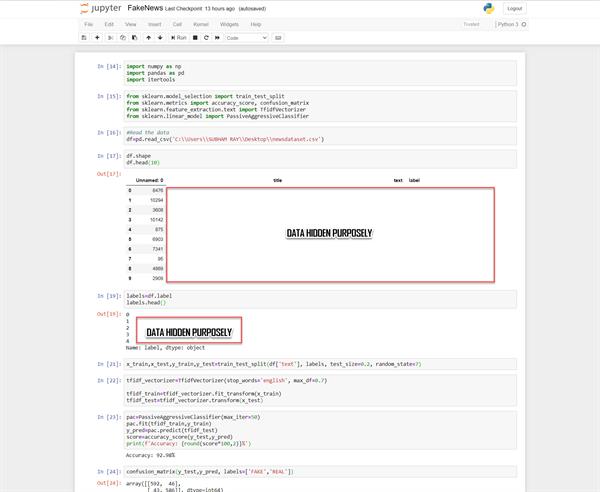How to Detect Fake News using Python
DataScience | Python | Detect Fake News
Detecting Fake News
In this article we will cover :
- What is Python?
- What is Fake News?
- The source code.
- Resources.
What is the Python Programming Language?
Python Programming language is an interpreted, object-oriented, high-level programming language with dynamic semantics, supporting modules and packages, which encourages program modularity and code reuse. It has the ability to create CSV output for easy data reading in a spreadsheet which alternatively more complicated file outputs that can be ingested by machine learning clusters for computation.
What is Fake News?
Fake News is Junk news or pseudo News, which usually contains disinformation, intended for misleading information for a particular topic that may contain fabricated headlines to increase readership.
The Source Code:
- Install libraries with pip
pip install numpy pandas sklearn - First import the important imports:
import numpy as np import pandas as pd import itertools - After that import from sklearn
from sklearn.model_selection import train_test_split from sklearn.metrics import accuracy_score, confusion_matrix from sklearn.feature_extraction.text import TfidfVectorizer from sklearn.linear_model import PassiveAggressiveClassifier - Read the data from the dataset
#Read the data df=pd.read_csv('C:\\DataSet\\newsdataset.csv') - Shape and read your dataset and understand
df.shape df.head(10) - Get the labels from DataFrame from the dataset
labels=df.label labels.head() - Split Dataset into training and testing sets
x_train,x_test,y_train,y_test=train_test_split(df['text'], labels, test_size=0.2, random_state=7) - fit and transform the vectorizer on the train set, and transform the vectorizer
tfidf_vectorizer=TfidfVectorizer(stop_words='english', max_df=0.7) tfidf_train=tfidf_vectorizer.fit_transform(x_train) tfidf_test=tfidf_vectorizer.transform(x_test) - Initialize the Passive-Aggressive Classifier
pac=PassiveAggressiveClassifier(max_iter=50) pac.fit(tfidf_train,y_train) y_pred=pac.predict(tfidf_test) score=accuracy_score(y_test,y_pred) print(f'Accuracy: {round(score*100,2)}%') - Apply Confusion Matrix to gain insights
confusion_matrix(y_test,y_pred, labels=['FAKE','REAL'])

Resources
- https://www.python.org/
- https://datascience.berkeley.edu/about/what-is-data-science





